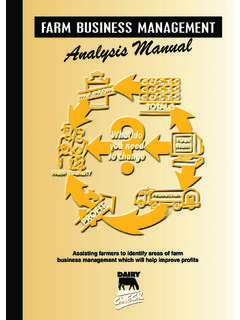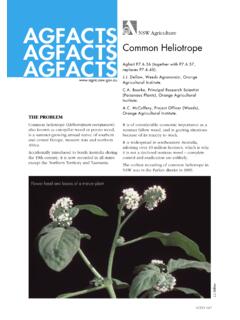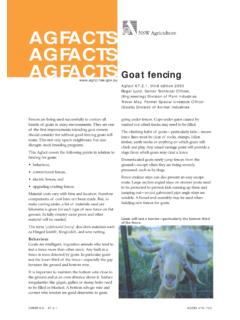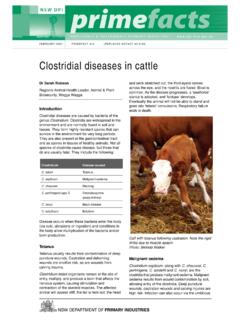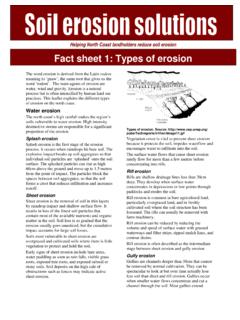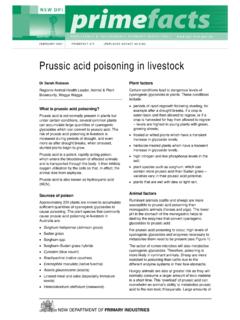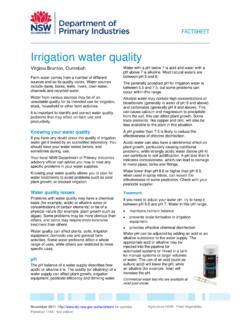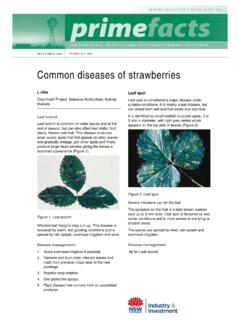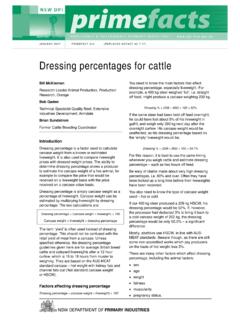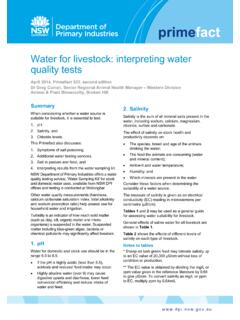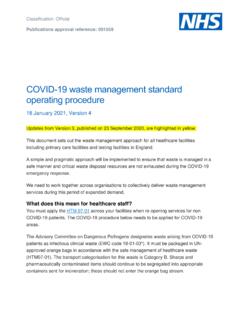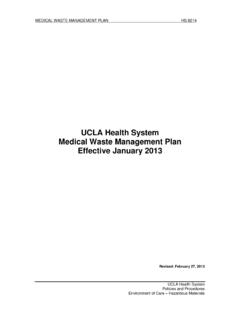Transcription of Waste management plan template - Department of Primary ...
1 INSERT COMPANY LOGO Waste management Plan Prepared By: Insert Author Insert Month Year Waste management Plan EMP. TABLE OF CONTENTS LIST OF TABLES .. i 1 Introduction .. 2 2 Waste Types .. 2 Waste Categories ..3 residual 3 Waste Collection and Disposal .. 4 Dead and Diseased Stock ..4 Longline Sanitary, Grey and Black Water Contaminated / Hazardous 4 Waste 7 5 Monitoring .. 8 6 Consultation .. 9 7 9 LIST OF TABLES Table 1: Waste types and Waste management practices (Australian Waste Classification system AA004643 - 2011)..3 INSERT PROPONENT INSERT MONTH YEAR i Waste management Plan EMP.
2 1 Introduction The purpose of the Waste management Plan is to describe the principles, procedures and management of the Waste generated by the INSERT LEASE NAME. INSERT PROPONENT has developed this Plan to ensure wastes are reduced, reused and recycled wherever possible. In accordance with consent condition INSERT DETAILS ( D22 and D23 of the State Significant Infrastructure Approval SS1-5118), the Waste management Plan outlines measures to manage and mitigate Waste generation and resource consumption during the operation of the development. The Plan includes details on the following: LIST DOT POINTS OF CONSENT CONDITIONS The types and quantities of Waste generated during operation; Procedures to collect and dispose of Waste ; Measures that will be implemented to minimise Waste generation associated with the development; and A program for monitoring the effectiveness of these measures. The Waste management Plan is designed to support an ecological based management approach underpinned by adaptive management principles.
3 Surplus or Waste materials arise from either the materials imported to the site or from those generated on the site. Imported materials are those which are brought to the site for inclusion in the operations. Generated materials are those that occur during the daily operations of the site damaged stock and Waste water. This Plan also considers other aspects to Waste management such as Waste reduction, segregation of Waste , disposal of Waste , financial impacts of Waste disposal and recording, monitoring, education and reviewing. This Plan outlines the Waste management procedures that have been put in place and demonstrate the benefits to the environment, how we can measure the effects and how these procedures and practices are sustainable. 2 Waste Types The operation of the INSERT LEASE NAME will generate a range of wastes, including bio Waste ( biofouling and damaged stock), general Waste ( plastic, containers and bags), obsolete/worn infrastructure ( ropes and nets) and contaminated/hazardous wastes ( human wastes and diseased stock).
4 INSERT PROPONENT INSERT MONTH YEAR 2 Waste management Plan EMP. Waste Categories Table 1 provides an overview of the potential wastes, their classification and avenues of disposal. Table 1: Waste types and Waste management practices (Australian Waste Classification system AA004643 2011). Waste Types Waste Form Australian Waste Code Waste Origin Code Waste Stream Waste Destination Dead shellfish L & S K100 1120 Composting/ensiling EPA Approved Contractor Paper Waste S Un-coded 1120 Landfill (soiled) or recycling LOCATION Waste transfer station or Contractor Plastic Packaging S Un-coded 1120 Recycling Recycling depot Plastic Bags S Un-coded 1120 Recycling Recycling depot Cardboard Packaging S Un-coded 1120 Recycling Recycling depot Rags S Un-coded 1120 Landfill LOCATION Waste transfer station Pallets S Un-coded 1120 Returned Contractor Waste Rope S Un-coded 1120 Recycled polypropylene Recycling depot Empty 20 litre Steel Drums S Un-coded 1120 Reuse on site Or Recycled Recycled via Contractor or sent back to supplier Empty 200 litre Steel Drums S Un-coded 1120 Reuse on site Or Recycled Recycled via Contractor or sent back to supplier Sanitary Products S Un-coded 1120 Incinerated Contracted Approved Sanitary disposal Services Waste oil L J120 1120 Recycled Approved Contractor Grey and Black Water L Bio-solid 1120 Sullage tank on vessels land based sewage systems Onshore services provide or approved Contractor Waste materials fall into four
5 Categories for management , which include: Re use; Recycle; residual wastes; and Landfill. INSERT PROPONENT INSERT MONTH YEAR 3 Waste management Plan EMP. Re-use If surplus materials can be used in future operations they are classified as materials which can be re-used, rope off cuts and spare netting. Materials that can be reused in their present form are surplus to requirements and need to be removed from site will be reused.
6 The surplus products will be labelled and storage area recorded for future reference. Recycling If surplus materials cannot be reused in their present form but could be used in a different form, they will be sent to recycling or labelled as future recycling damaged stock and biofouling may be composted as potential fertilisers. residual Waste residual Waste can come in several forms including: Waste that cannot be disposed of due to its category, class or material ( old tyres, metals and contaminated Waste ). Ways of reusing or disposing of the Waste from the site needs to found; and Unused machinery, spare parts or discarded parts. All items of this nature will be identified and dated. These items will be assessed quarterly to gauge their importance for potential future use. Once an item is deemed to have little or no future potential to be utilised, it will be either assessed for reuse in another form or disposed of from the site.
7 residual Waste can be an eyesore, fire hazard and has potential to impact on the environment through leachates. All residual wastes will be identified and new residual wastes will be added to the residual Waste catalogue for quarterly auditing. residual wastes that are deemed essential or have the potential for future use will be stored in a neat and tidy manner and where possible under cover to avoid or reduce the potential for further corrosion or damage to the product. Landfill If the above options cannot be satisfied then the only alternative left is to send the surplus materials to landfill. Under no circumstances will biological (except biofouling) or non-biological Waste be dumped into the ocean. 3 Waste Collection and Disposal Dead and Diseased Stock Dead and diseased shellfish/finfish will be put into Waste storage bins on service vessels where lids will be tightly secured to prevent spillages, attraction of pests or odour issues.
8 The Waste bins INSERT PROPONENT INSERT MONTH YEAR 4 Waste management Plan EMP. will then be returned to land and depending on the quantity of Waste , it will be disposed of potentially through the INSERT NAME Waste disposal facility or transported by road to an appropriate composting or Waste disposal facility in the local area.
9 The containers will then be cleaned and disinfected before being returned to the service vessels (Worth & Joyce, 2001). All dead and diseased shellfish/finfish will be taken ashore for disposal under no circumstances will dead or diseased shellfish/finfish be disposed of at sea (Environment Protection Authority, 2007). Biofouling The INSERT LEASE NAME infrastructure will be colonised naturally by a range of marine biofouling organisms, such as algae, ascidians, molluscs and barnacles. The removal of this biofouling from the infrastructure is important to reduce its resistance to currents and wave action which may jeopardise the integrity of the infrastructure stress moorings and cause the stock to sit too closely to the seabed (Braithwaite et al., 2007). Biofouling removal is also important to maintain water quality, reduce the availability of habitat for diseases and parasites and to minimise the attraction of wild fauna ( herbivorous fishes) which feed on it and can cause damage to the infrastructure (Braithwaite et al.)
10 , 2007). Infrastructure including culture apparatus will either be taken to the land based site for cleaning, cleaned in situ or it will be cleaned on-site using pressure cleaning equipment. On board pressure cleaning equipment used for the culture apparatus (which will depend on the types of species cultured), would consist of a power unit (pump), filter unit and cleaning unit. A winch will be used to pull the longlines up from the water, which will then be attached to rollers along the side of the vessel. Lines, nets, cages, baskets and/or trays containing the shellfish/finfish will be pulled onto the vessel and positioned on a conveyor belt that will take them through a cleaning unit consisting of a series of high pressure sprays and collection tanks (Umwelt, 2003). Biofouling and sediment will be removed and then the lines, cages and/or nets will be returned to the leases. Water used in the on board cleaning process will be pumped from and returned to Jervis Bay.
